
Roman relief (3rd century CE) depicting a sequence of the Labours of Hercules, representing from left to right the Nemean Lion, the Lernaean Hydra, the Erymanthian Boar, the Ceryneian Hind, the Stymphalian birds, the Girdle of Hippolyte, the Augean stables, the Cretan Bull and the Mares of Diomedes
The twelve labours of Hercules or dodekathlon (Greek: δωδέκαθλον, dodekathlon) are a series of episodes concerning a penance carried out by Heracles, the greatest of the Greek heroes, whose name was later romanised as Hercules. They were later connected by a continuous narrative. The establishment of a fixed cycle of twelve labours was attributed by the Greeks to an epic poem, now lost, written by Peisandros of Rhodes, dated about 600 BC.[1]
Context[]
Driven mad by Hera, Hercules slew his own six sons. After recovering his sanity, Hercules deeply regretted his actions; he was purified by King Thespius, then traveled to Delphi to inquire how he could atone for his actions. There the oracle Pythoness advised him to reside at Tyrins and serve King Eurystheus for twelve years, performing whatever labour might beset him; in return, he would be rewarded with immortality. Hercules despaired at this, loathing to serve a man whom he knew to be far inferior to himself, yet afraid to oppose his father Zeus. Eventually he placed himself at Eurystheus's disposal.
Eurystheus ordered Hercules to perform ten labours. Hercules accomplished these tasks, but Eurystheus refused to recognize two: the cleansing of the Augeas, because Hercules was going to accept pay for the labour; and the killing of the Lernaean Hydra, as Hercules' nephew and charioteer Iolaus had helped him burn the stumps of the heads. Eurystheus set two more tasks (fetching the Golden Apples of Hesperides and capturing Cerberus), which Hercules performed successfully, bringing the total number of tasks to twelve.
The labours[]
As they survive, the labours of Hercules are not told in any single place, but must be reassembled from many sources. Ruck and Staples[2] assert that there is no one way to interpret the labours, but that six were located in the Peloponnese, culminating with the rededication of Olympia. Six others took the hero farther afield. In each case, the pattern was the same: Hercules was sent to kill or subdue, or to fetch back for Hera's representative Eurystheus a magical animal or plant. "The sites selected were all previously strongholds of Hera or the 'Goddess' and were Entrances to the Netherworld".[2]
A famous depiction of the labours in Greek sculpture is found on the metopes of the Temple of Zeus at Olympia, which date to the 450s BCE.
In his labours, Hercules was sometimes accompanied by a male companion (an eromenos), according to Licymnius and others, such as Iolaus, his nephew. Although he was only supposed to perform ten labours, this assistance led to his suffering two more. Eurystheus did not count the Hydra, because Iolaus helped him, or the Augean stables, as he received payment for his work, or because the rivers did the work. Several of the labours involved the offspring (by various accounts) of Typhon and his mate Echidna, all overcome by Hercules.
A traditional order of the labours found in the Bibliotheca[3] is:
- Slay the Nemean Lion.
- Slay the nine-headed Lernaean Hydra.
- Capture the Golden Hind of Artemis.
- Capture the Erymanthian Boar.
- Clean the Augean stables in a single day.
- Slay the Stymphalian Birds.
- Capture the Cretan Bull.
- Steal the Mares of Diomedes.
- Obtain the girdle of Hippolyta, Queen of the Amazons.
- Obtain the cattle of the monster Geryon.
- Steal the apples of the Hesperides (He had the help of Atlas to pick them after Hercules had slain Ladon).
- Capture and bring back Cerberus.
First Labour: Nemean lion[]
The first of Hercules' twelve labours, set by his cousin King Eurystheus, was to slay the Nemean lion.
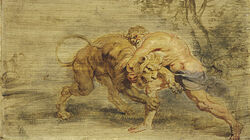
17th century depiction of Hercules fighting the Nemean lion by Peter Paul Rubens.
According to one version of the myth, the Nemean lion took women as hostages to its lair in a cave near Nemea, luring warriors from nearby towns to save the damsel in distress. After entering the cave, the warrior would see the woman (usually feigning injury) and rush to her side. Once he was close, the woman would turn into a lion and kill the warrior, devouring his remains and giving the bones to Hades.
Hercules wandered the area until he came to the town of Cleonae. There he met a boy who said that if Hercules slew the Nemean lion and returned alive within 30 days, the town would sacrifice a lion to Zeus, but if he did not return within 30 days or he died, the boy would sacrifice himself to Zeus. Another version claims that he met Molorchos, a shepherd who had lost his son to the lion, saying that if he came back within 30 days, a ram would be sacrificed to Zeus. If he did not return within 30 days, it would be sacrificed to the dead Heracles as a mourning offering.
While searching for the lion, Hercules fletched some arrows to use against it, not knowing that its golden fur was impenetrable; when he found and shot the lion and firing at it with his bow, he discovered the fur's protective property when the arrow bounced harmlessly off the creature's thigh. After some time, Hercules made the lion return to his cave. The cave had two entrances, one of which Hercules blocked; he then entered the other. In those dark and close quarters, Hercules stunned the beast with his club and, using his immense strength, strangled it to death. During the fight the lion bit off one of his fingers. Others say that he shot arrows at it, eventually shooting it in the unarmored mouth. After slaying the lion, he tried to skin it with a knife from his belt, but failed. He then tried sharpening the knife with a stone and even tried with the stone itself. Finally, Athena, noticing the hero's plight, told Heracles to use one of the lion's own claws to skin the pelt. Others say that Hercules' armor was, in fact, the hide of the lion of Cithaeron.
When he returned on the thirtieth day carrying the carcass of the lion on his shoulders, King Eurystheus was amazed and terrified. Eurystheus forbade him ever again to enter the city; in future he was to display the fruits of his labours outside the city gates. In future, Eurystheus told Heracles his tasks through a herald, not personally. Eurystheus even had a large bronze jar made for him that he could hide in from Heracles if need be. Eurystheus then warned him that the tasks set for him would become increasingly difficult. He then sent Hercules off to complete his next quest, which was to destroy the Lernaean Hydra.
Second Labour: Lernaen Hydra[]
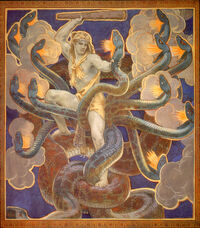
1921 painting of Hercules fighting the Lernaean Hydra by John Singer Sargent.
After slaying the Nemean lion, Eurystheus sent Hercules to slay the Hydra, which Hera had raised just to slay Hercules. Upon reaching the swamp near Lake Lerna, where the Hydra dwelt, Hercules covered his mouth and nose with a cloth to protect himself from the poisonous fumes. He fired flaming arrows into the Hydra's lair, the spring of Amymone, a deep cave that it only came out of to terrorize neighboring villages.[4] He then confronted the Hydra, wielding a harvesting sickle (according to some early vase-paintings), a sword or his famed club. Ruck and Staples (1994: 170) have pointed out that the chthonic creature's reaction was botanical: upon cutting off each of its heads he found that two grew back, an expression of the hopelessness of such a struggle for any but the hero. The weakness of the Hydra was that only one of its heads was immortal.
The details of the struggle are explicit in the Bibliotheca (2.5.2): realizing that he could not defeat the Hydra in this way, Hercules called on his nephew Iolaus for help. His nephew then came upon the idea (possibly inspired by Athena) of using a firebrand to scorch the neck stumps after each decapitation. Hercules cut off each head and Iolaus cauterized the open stumps. Seeing that Hercules was winning the struggle, Hera sent a large crab to distract him. He crushed it under his mighty foot. The Hydra's one immortal head was cut off with a golden sword given to him by Athena. Hercules placed it under a great rock on the sacred way between Lerna and Elaius (Kerenyi 1959:144), and dipped his arrows in the Hydra's poisonous blood, and so his second task was complete. The alternative version of this myth is that after cutting off one head he then dipped his sword in it and used its venom to burn each head so it couldn't grow back. Hera, upset that Hercules slew the beast she raised to kill him, placed it in the dark blue vault of the sky as the Constellation Hydra. She then turned the crab into the Constellation Cancer.
Hercules later used an arrow dipped in the Hydra's poisonous blood to kill the centaur Nessus; and Nessus's tainted blood was applied to the Tunic of Nessus, by which the centaur had his posthumous revenge. Both Strabo and Pausanias report that the stench of the river Anigrus in Elis, making all the fish of the river inedible, was reputed to be due to the Hydra's poison, washed from the arrows Heracles used on the centaur.[5]
Third Labour: Ceryneian Hind[]
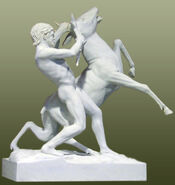
Hercules captures the Ceryneian Hind, statuette by J.M. Felix Magdalena.
Eurystheus and Hera were greatly angered to find that Hercules had managed to escape from the claws of the Nemean Lion and the fangs of the Lernaean Hydra, and so decided to spend more time thinking up a third task that would spell doom for the hero. The third task did not involve killing a beast, as it had already been established that Hercules could overcome even the most fearsome opponents, so Eurystheus decided to make him capture the Ceryneian Hind, as it was so fast it could outrun an arrow.
After beginning the search, Hercules awoke from sleeping and he could see the hind from the glint on its antlers. Hercules then chased the hind on foot for a full year through Greece, Thrace, Istria and the land of the Hyperboreans. In some versions, he captured the hind while it slept, rendering it lame with a trap net. In other versions, he encountered Artemis in her temple and she told him to leave the hind and tell Eurystheus all that had happened and his third labor would be considered to be completed. Yet another version claims that Heracles trapped the Hind with an arrow between the forelegs of the creature.
Eurystheus had given Hercules this task hoping to incite Artemis' anger at Hercules for his desecration of her sacred animal. As he was returning with the hind, Hercules encountered Artemis and her brother Apollo. He begged the goddess for forgiveness, explaining that he had to catch it as part of his penance, but he promised to return it. Artemis forgave him, foiling Eurystheus' plan to have her punish him.
Upon bringing the hind to Eurystheus, he was told that it was to become part of the King's menagerie. Hercules knew that he had to return the hind as he had promised, so he agreed to hand it over on the condition that Eurystheus himself come out and take it from him. The King came out, but the moment Hercules let the hind go, it sprinted back to its mistress, and Heracles left saying that Eurystheus had not been quick enough. Eurystheus, upset that Heracles had managed to overcome yet another creature, told him to bring the fearsome Erymanthian Boar back to him alive.
Fourth Labour: Erymanthian Boar[]
Hercules' fourth labour—by some counts, for there is no single definitive telling—was to capture the Boar. On the way there, Hercules visited Pholus ("caveman"), a kind and hospitable centaur and old friend. Hercules ate with him in his cavern—though the centaur devoured his meat raw—and asked for wine. Pholus had only one jar of wine, a gift from Dionysus to all the centaurs on Mt. Erymanthos. Hercules convinced him to open it, and the smell attracted the other centaurs. They did not understand that wine needs to be tempered with water, became drunk, and attacked. Hercules shot at them with his poisonous arrows, and the centaurs retreated all the way to Chiron's cave.
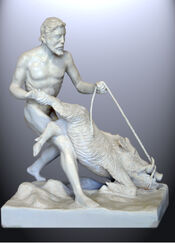
Hercules captures the Erymanthian Boar, statuette by J.M. Felix magdalena
Pholus was curious why the arrows caused so much death, and picked one up but dropped it, and the arrow stabbed his foot, poisoning him. One version states that a stray arrow hit Chiron as well, but Chiron was immortal, although he still felt the pain. Chiron's pain was so great, he volunteered to give up his immortality, and take the place of Prometheus, who had been chained in to the top of a mountain to have his liver eaten daily by an eagle, although he was an immortal Titan. Prometheus' torturer, the eagle, continued its torture on Chiron, so Hercules shot it dead with an arrow. It is generally accepted that the tale was meant to show Hercules as being the recipient of Chiron's surrendered immortality. However, this tale contradicts the fact that Chiron later taught Achilles. The tale of the Centaurs sometimes appears in other parts of the twelve labours, as does the freeing of Prometheus.
Hercules had visited Chiron to gain advice on how to catch the boar, and Chiron had told him to drive it into thick snow, which sets this Labour in mid-winter. Having successfully caught the Boar, Hercules bound it and carried it back to Eurystheus, who was frightened of it and ducked down in his half-buried storage pithos, begging Heracles to get rid of the beast, a favorite subject for the vase-painters. Heracles obliged. Roger Lancelyn Green states in his Tales of the Greek Heroes that Hercules threw it in the sea. It then swam to Italy, where its tusks were preserved in the Temple of Apollo at Cumae. Three days later, Eurystheus, still trembling with fear, sent Hercules to clean the Augean stables.
Fifth Labour: Augean stables[]
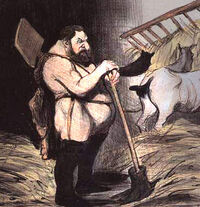
1842 depiction of Hercules cleaning the Augean stables by Honore Daumier.
The fifth Labour of Hercules was to clean the Augean stables. This assignment was intended to be both humiliating (rather than impressive, as had the previous labours) and impossible, since the livestock were divinely healthy (immortal) and therefore produced an enormous quantity of dung. These stables had not been cleaned in over thirty years, and over 1,000 cattle lived there. However, Hercules succeeded by rerouting the rivers Alpheus and Peneus to wash out the filth.
Augeaswas irate because he had promised Hercules one tenth of his cattle if the job was finished in one day. He refused to honour the agreement, and Heracles killed him after completing the tasks. Hercules gave his kingdom to Augeas' son Phyleus, who had been exiled for supporting Heracles against his father. According to the Odes of the poet Pindar, Hercules then founded the Olympic Games:
| “ | the games which by the ancient tomb of Pelops the mighty Hercules founded, after that he slew Kleatos, Poseidon's godly son, and slew also Eurytos, that he might wrest from tyrannous Augeas against his will reward for service done.[6] | ” |
The success of this labour was ultimately discounted because the rushing waters had done the work of cleaning the stables and because Hercules was paid. Eurystheus, stating that Heracles still had seven Labours to do, then sent Hercules to defeat the Stymphalian birds.
Sixth Labour: Stymphalian Birds[]
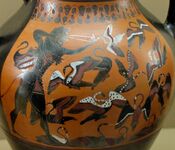
This piece of Greek pottery from the 6th century BCE depicts Hercules killing the Stymphalian birds.
After cleaning the Augean Stables, Eurystheus sent Hercules to defeat the Stymphalian Birds, man-eating birds with beaks of bronze and sharp metallic feathers they could launch at their victims, and were sacred to Ares, the god of war. Furthermore, their dung was highly toxic. They had migrated to Lake Stymphalia in Arcadia and bred quickly and took over the countryside, destroying local crops, fruit trees and townspeople. Hercules could not go too far into the swamp, for it would not support his weight. Athena, noticing the hero's plight, gave Heracles a rattle which Hephaestus had made especially for the occasion. Hercules shook the rattle and frightened the birds into the air. Hercules then shot many of them with his arrows. The rest flew far away, never to return. The Argonauts would later encounter them.
Seventh Labour: Cretan Bull[]
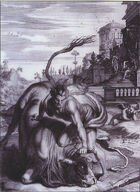
Hercules forces the bull to the ground (engraving by B. Picart, 1731)
Whistling merrily at his success so far, Hercules was then sent to capture the bull by Eurystheus as his seventh task. He sailed to Crete, whereupon the King, Minos, gave Hercules permission to take the bull away and offered him assistance, which Hercules denied because of pride,[7] as it had been wreaking havoc on Crete by uprooting crops and leveling orchard walls. Hercules snuck up behind the bull and then used his hands to strangle it, and then shipped it back to Athens. Eurystheus, who hid in his pithos at first sight of the creature, wanted to sacrifice the bull to Hera, who hated Hercules. She refused the sacrifice because it reflected glory on Hercules. The bull was released and wandered into Marathon, becoming known as the Marathonian Bull.[7] Theseus would later sacrifice the bull to Athena and/or Apollo. Eurystheus then sent Hercules to bring back the man-eating Mares of Diomedes.
Eighth Labour: Mares of Diomedes[]
After capturing the Cretan Bull, Hercules was to steal the Mares. In one version of the story, Hercules brought a number of youths to help him. They took the mares and were chased by Diomedes and his men.
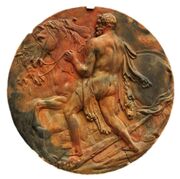
Hercules and the Mares of Diomedes, model for a tondo of the Brandenburg Gate (terracotta relief by Johann Gottfried Schadow, ca. 1790)
Hercules was not aware that the horses, called Podagros (the fast), Lampon (the shining), Xanthos (the blond) and Deinos (the terrible), were kept tethered to a bronze manger because they were wild; their madness being attributed to an unnatural diet of human flesh.[8] Some versions say that they expelled fire when they breathed. They were man-eating and uncontrollable, and Hercules left his favoured companion, Abderus, in charge of them while he fought Diomedes, and found out that the boy was eaten. In revenge, Hercules fed Diomedes to his own horses, then founded Abdera next to the boy's tomb.
In another version, Hercules stayed awake so that he did not have his throat cut by Diomedes in the night, and cut the chains binding the horses. Having scared the horses onto the high ground of a peninsula, Heracles quickly dug a trench through the peninsula, filling it with water, thus making it an island. When Diomedes arrived, Hercules killed him with an axe (the one used to dig the trench), and fed the body to the horses to calm them.
Both versions have eating make the horses calmer, and Hercules took the opportunity to bind their mouths shut, and easily took them back to King Eurystheus, who dedicated the horses to Hera. In some versions, they were allowed to roam freely around Argos, having become permanently calm, but in others, Eurystheus ordered the horses taken to Olympus to be sacrificed to Zeus, but Zeus refused them, and sent wolves, lions, and bears to kill them. Roger Lancelyn Green states in his Tales of the Greek Heroes that their descendants were used in the Trojan War. After the incident, Eurystheus sent Heracles to bring back Hippolyta's Girdle.
Ninth Labour: Belt of Hippolyta[]
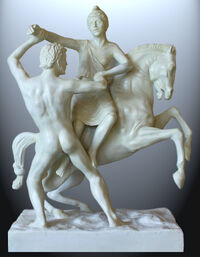
Hercules obtaining the belt of Hippolyta, statuette by J.M. Félix Magdalena.
Eurystheus' daughter Admete wanted the belt of Hippolyta, a gift to the queen of the Amazons from the war god Ares. To please his daughter, Eurystheus ordered Hercules to retrieve the belt as his ninth labour.
Taking a band of friends with him, Hercules set sail, stopping at the island of Paros, which was inhabited by some of Minos' sons. These killed two of Hercules' companions, an act which set Hercules on a rampage. He killed two of Minos' sons and threatened the other inhabitants until he was offered two men to replace his fallen companions. Hercules agreed and took two of Minos' grandsons, Alcaeus and Sthenelus. They continued their voyage and landed at the court of Lycus, whom Hercules defended in a battle against the king of the Bebryces, Mygdon. After killing King Mygdon, Hercules gave much of the land to his friend Lycus. Lycus called the land Heraclea. The crew then set off for Themiscyra where Hippolyte lived.
All would have gone well for Hercules had it not been for Hera. Hippolyte, impressed with Hercules and his exploits, agreed to give him the belt and would have done so had Hera not disguised herself and walked among the Amazons sowing seeds of distrust. She claimed the strangers were plotting to carry off the queen of the Amazons. Alarmed, the women set off on horseback to confront Hercules. When Hercules saw them, he thought Hippolyte had been plotting such treachery all along and had never meant to hand over the belt, so he killed her and took the belt, returning to Eurystheus. Eurystheus, shocked that Hercules survived his encounter with the Amazons, immediately sent him to capture the cattle of Geryon.
Tenth Labour: Cattle of Geryon[]
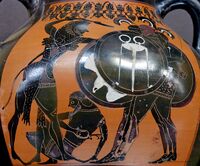
This piece of Greek pottery from the 6th century BCE depicts Hercules fighting Geryon.
In the fullest account in the Bibliotheke of Pseudo-Apollodoros,[9] Heracles was required to travel to the far-off western Mediterranean island of Erytheia, in order to obtain the Cattle of Geryon as his tenth labour. On the way there, he crossed the Libyan desert[10] and became so frustrated at the heat that he shot an arrow at Helios, the Sun. Helios "in admiration of his courage" gave Hercules the golden cup he used to sail across the sea from west to east each night. Hercules used it to reach Erytheia, a favorite motif of the vase-painters. Such a magical conveyance undercuts any literal geography for Erytheia, the "red island" of the sunset.
When Hercules reached Erytheia, no sooner had he landed than he was confronted by the two-headed dog, Orthrus. With one huge blow from his olive-wood club, Heracles killed the watchdog. Eurytion the herdsman came to assist Orthrus, but Hercules dealt with him the same way.
On hearing the commotion, Geryon sprang into action, carrying three shields, three spears, and wearing three helmets. He pursued Hercules at the River Anthemus but fell victim to an arrow that had been dipped in the venomous blood of the Lernaean Hydra, shot so forcefully by Heracles that it pierced Geryon's forehead, "and Geryon bent his neck over to one side, like a poppy that spoils its delicate shapes, shedding its petals all at once".[11]
Hercules then had to herd the cattle back to Eurystheus. In Roman versions of the narrative, on the Aventine hill in Italy, Cacus stole some of the cattle as Hercules slept, making the cattle walk backwards so that they left no trail, a repetition of the trick of the young Hermes. According to some versions, Hercules drove his remaining cattle past a cave, where Cacus had hidden the stolen animals, and they began calling out to each other. In others, Caca, Cacus' sister, told Heracles where he was. Hercules then killed Cacus, and according to the Romans, founded an altar where the Forum Boarium, the cattle market, was later held.
To annoy Hercules, Hera sent a gadfly to bite the cattle, irritate them and scatter them. The hero was within a year able to retrieve them. Hera then sent a flood which raised the level of a river so much, Heracles could not cross with the cattle. He piled stones into the river to make the water shallower. When he finally reached the court of Eurystheus, the cattle were sacrificed to Hera.
Eleventh Labour: Apples of the Hesperides[]
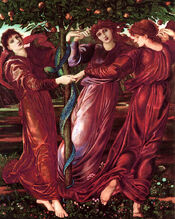
The Garden of the Hesperides, 19th century painting by Edward Burne-Jones.
After Hercules completed his first ten Labours, Eurystheus gave him two more claiming that neither the Hydra counted (because Iolaus helped Hercules) nor the Augean stables (either because he received payment for the job or because the rivers did the work). The first of these two additional Labours was to steal the golden apples from the garden of the Hesperides. Hercules first caught the Old Man of the Sea,[12] the shape-shifting sea god, to learn where the Garden of the Hesperides was located.[13]
In some variations, Hercules, either at the start or at the end of his task, meets Antaeus, who was invincible as long as he touched his mother, Gaia, the earth. Hercules killed Antaeus by holding him aloft and crushing him in a bearhug.[14]
Herodotus claims that Hercules stopped in Egypt, where King Busiris decided to make him the yearly sacrifice, but Hercules burst out of his chains.
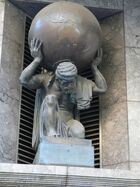
Sculpture of Atlas in Melbourne, Australia.
Finally making his way to the Garden of the Hesperides, Hercules tricked Atlas into retrieving some of the golden apples for him, by offering to hold up the heavens for a little while (Atlas was able to take them as, in this version, he was the father or otherwise related to the Hesperides). This would have made this task – like the Hydra and Augean stables – void because he had received help. Upon his return, Atlas decided that he did not want to take the heavens back, and instead offered to deliver the apples himself, but Hercules tricked him again by agreeing to take his place on condition that Atlas relieve him temporarily so that Hercules could make his cloak more comfortable. Atlas agreed, but Hercules reneged and walked away, carrying the apples. According to an alternative version, Hercules slew Ladon, the dragon-like guardian of the apples, instead. Furious that Hercules had accomplished something that Eurystheus thought could not possibly be done, he sent Hercules off to his final task, the capture of Cerberus, the three-headed guardian hound of the gates of the Underworld.
Twelfth Labour: Cerberus[]
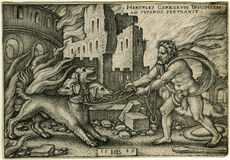
Hercules capturing Cerberus (1545), by Sebald Beham.
Capturing Cerberus alive, without using weapons, was the final labour assigned to Hercules by Eurystheus, in recompense for the killing of his own children by Megara after he was driven insane by Hera, and therefore was the most dangerous and difficult.
After having been given the task, Hercules went to Eleusis to be initiated in the Eleusinian Mysteries so that he could learn how to enter and exit the Underworld alive, and in passing absolve himself for killing centaurs. He found the entrance to the underworld at Tanaerum, and Athena and Hermes helped him to traverse the entrance in each direction. He passed Charon with Hestia's assistance and his own heavy and fierce frowning.
Whilst in the underworld, Hercules met Theseus and Pirithous. The two companions had been imprisoned by Hades for attempting to kidnap Persephone. One tradition tells of snakes coiling around their legs then turning into stone; another that Hades feigned hospitality and prepared a feast inviting them to sit. They unknowingly sat in chairs of forgetfulness and were permanently ensnared. When Hercules had pulled Theseus first from his chair, some of his thigh stuck to it (this explains the supposedly lean thighs of Athenians), but the earth shook at the attempt to liberate Pirithous, whose desire to have the wife of a god for himself was so insulting he was doomed to stay behind.
Hercules found Hades and asked permission to bring Cerberus to the surface, which Hades agreed to if Hercules could overpower the beast without using weapons. Heracles was able to overpower Cerberus and proceeded to sling the beast over his back, dragging it out of the underworld through a cavern entrance in the Peloponnese and bringing it to Eurystheus. The king was so frightened of the beast that he jumped into a pithos, and asked Hercules to return it to the underworld in return for releasing him from his labors.
As a reward for finishing these twelve treacherous tasks, he was given the gift of immortality after his death by his father Zeus. Hera forgave him and gave him her daughter Hebe for his bride.
References[]
- ↑ According to Walter Burkert.
- ↑ 2.0 2.1 Ruck, Carl; Danny Staples (1994). The World of Classical Myth. Durham, NC, USA: Carolina Academic Press. pp. 169.
- ↑ Pseudo-Apollodorus, Bibliotheke 2.5.1-2.5.12.
- ↑ Kerenyi, The Heroes of the Greeks(angelo) 1959:144.
- ↑ Strabo, viii.3.19, Pausanias, v.5.9; Grimal 1987:219.
- ↑ Pindar. The Extant Odes of Pindar, Project Gutenberg.
- ↑ 7.0 7.1 Bibliotheca 2.5.7
- ↑ Horse madness (hippomania) and hippophobia, Yiannis G. Papakostas, Michael D. Daras, Ioannis A. Liappas and Manolis Markianos, History of Psychiatry 2005; 16; 467
- ↑ Pseudo-Apollodorus. Bibliotheke, 2.5.10.
- ↑ Libya was the generic name for North Africa to the Greeks.
- ↑ Stesichorus, fragment, translated by Denys Page.
- ↑ Kerenyi, The Heroes of the Greeks, 1959, p.172, identifies him in this context as Nereus; as a shape-shifter he is often identified as Proteus.
- ↑ In some versions of the tale, Hercules was directed to ask Prometheus. As payment, he freed Prometheus from his daily torture. This tale is more usually found in the position of the Erymanthian Boar, since it is associated with Chiron choosing to forgo immortality and taking Prometheus' place.
- ↑ Apollodorus ii. 5; Hyginus, Fab. 31
- Burkert, Walter (1985). Greek Religion. Cambridge, MA, USA: Harvard University Press.
External links[]
- Labors of Heracles at the Livius Picture Archive
- The Labors of Hercules at the Perseus Digital Library
| |||||
| This page uses content from the English Wikipedia. The original article was at Labours of Hercules. The list of authors can be seen in the page history. |